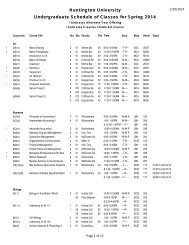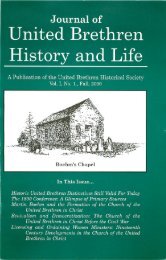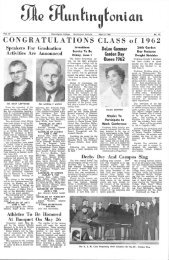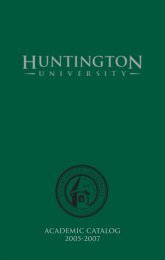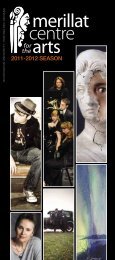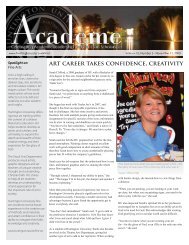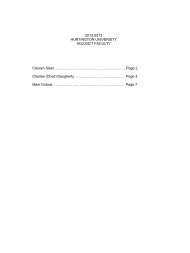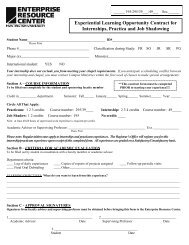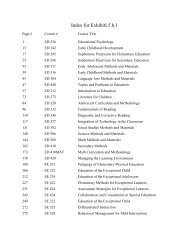Gillian Clark, Christianity and Roman Society - Huntington University
Gillian Clark, Christianity and Roman Society - Huntington University
Gillian Clark, Christianity and Roman Society - Huntington University
Create successful ePaper yourself
Turn your PDF publications into a flip-book with our unique Google optimized e-Paper software.
BOOK REVIEWS 109<br />
<strong>and</strong> unlike the medieval Catholic view, marriage belongs solely to the earthly realm. It is<br />
“a good <strong>and</strong> holy ordinance of God just like farming, building, cobbling, <strong>and</strong> barbering”<br />
(39). From this starting point, Calvin <strong>and</strong> his fellow reformers set about bringing the<br />
practice of marriage in Geneva more closely into line with a more secular conception. It<br />
comes as no surprise, therefore, that Calvin was intensely critical of “the Church’s<br />
‘usurpation’ of marital jurisdiction from the secular judges, its condoning of secret<br />
marriages of minors without parental consent, its restrictions on the seasons for<br />
engagement, its long roll of marital impediments beyond ‘the law of nations <strong>and</strong> of<br />
Moses,’ its easy dispensations from marital rules for the propertied <strong>and</strong> the powerful, its<br />
prohibitions against divorce <strong>and</strong> remarriage” (40)—even though the latter existed de<br />
facto, if not de jure for those who could pay.<br />
Unlike many of his reforming counterparts in other cities, however, Calvin’s view of<br />
marriage did not remain at this rather mundane, deconstructed level. One of the strongest<br />
features of the present work, in fact, is that it allows us to see the development of<br />
Calvin’s views over the course of his tenure in Geneva, as he preached through the Old<br />
<strong>and</strong> New Testaments, worked with the city government to put his ideas into practice, <strong>and</strong><br />
then refined his thinking through his pastoral work on the Consistory. It was this latter<br />
setting, in fact, which proved to be the real laboratory for the development of Calvin’s<br />
theology of marriage. The picture which emerges from these documents is that of a<br />
reformer committed to certain key insights, yet willing to rethink his teaching in<br />
conversation with scripture, his colleagues in Geneva <strong>and</strong> abroad, <strong>and</strong> with the practical<br />
exigencies of the situation “on the ground.” For example, the third chapter documents<br />
Calvin’s early efforts at matchmaking, a role he soon wisely ab<strong>and</strong>oned.<br />
The most important in change in Calvin’s thinking on marriage, the authors argue, is<br />
the development of his application of a theological concept, covenant, to the bond of<br />
marriage. Over the course of his tenure in Geneva, <strong>and</strong> especially in the last decade of his<br />
life, Calvin came to have a much more exalted view of marriage as “a symbol of our<br />
divine covenant with the Father” (489). This did not mean, of course, that marriage was<br />
itself sacramental; it might signify divine grace, but it could not confirm it. “Anyone who<br />
would classify such similitudes with the sacraments,” Calvin reaffirmed in 1559, “ought<br />
to be sent to a mental hospital.” Nevertheless, Witte <strong>and</strong> Kingdon convincingly document<br />
Calvin’s movement toward a view of marriage as “the holiest bond that God has set<br />
among us,” a sacred contract to which God himself acted as third party. A long way from<br />
cobbling, this. And the link between God’s creation ordinance <strong>and</strong> its redemptive purpose<br />
in marriage was the concept of covenant. Despite Calvin’s harsh rejection of the language<br />
of sacrament in marriage, the authors demonstrate that Calvin’s theology of marriage<br />
developed into a mediating position between “both the sacramental <strong>and</strong> the contractual<br />
models of marriage that pressed for recognition in his day” (488).<br />
Witte <strong>and</strong> Kingdon have inaugurated their new project with a superb first volume.<br />
The blend of source text <strong>and</strong> scholarly commentary allows the reader to test the authors’<br />
conclusions against the relevant textual evidence as the argument of the work unfolds,<br />
making this an ideal textbook for an upper-division undergraduate seminar on social<br />
history in early modern Europe or for a seminary course on the history of marriage <strong>and</strong>



